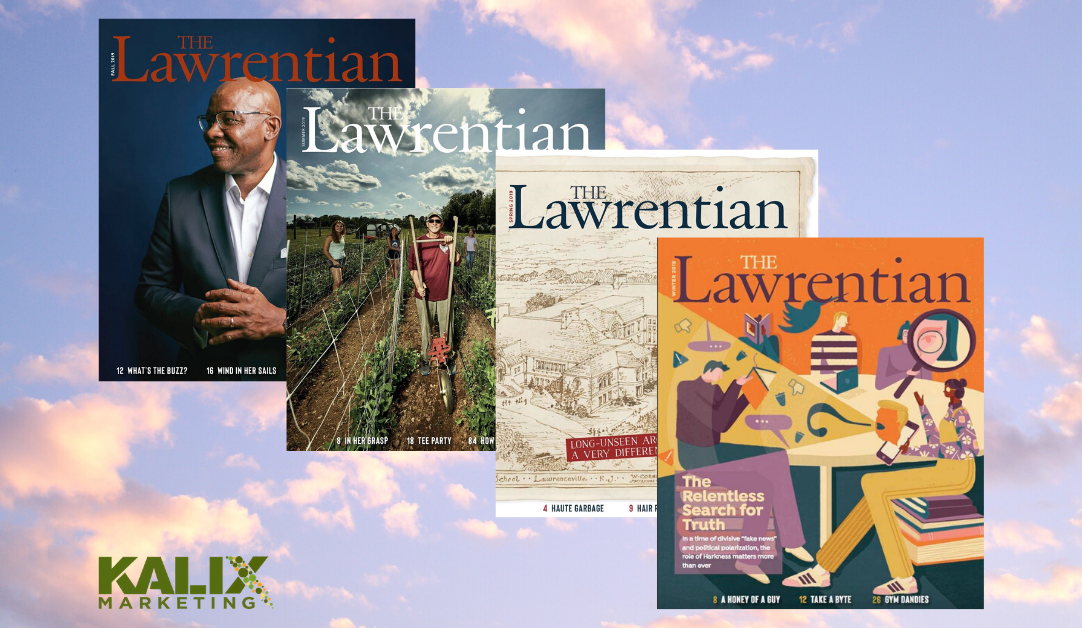Your school’s alumni magazine is one of the most important communications your constituency receives, yet, for most schools, publishing the magazine often gets pushed to the back burner, issue after issue.
We spoke with Sean Ramsden, editor of The Lawrentian, The Lawrenceville School’s award-winning, 80-page, quarterly alumni magazine, about creating engaging content, writing for today’s reader and why print is far from dead.
Q: How do you decide on magazine content and has it changed with Lawrenceville’s social media and web presence?
Sean: My dedicated role is exclusively to write, edit and produce The Lawrentian, which makes me a kind of unicorn in this business. On the flip side, I am really the only one who works on the magazine. We don’t have the budget to pay for freelancers. It’s my sole responsibility to plan for the entire editorial strategy for four issues a year, features and all the departments.
I try to pace it. If we do a heavier topic [in one issue], we do a lighter topic for the next issue. I think about the annual editorial flow and the ride [for the reader] over the course of the year. Each year is one lap around the track.
There really isn’t an overlap with Lawrenceville’s web news. Nearly everything in the magazine is original content. I am part of the Communications office and work closely with alumni and development but don’t have an editorial board. The magazine is a sub-brand for the school, and I approach it as a content strategist. What are the overarching view and things we need to touch on? Every feature story typically aligns with one of our four pillars in Lawrenceville’s strategic plan.
My mantra has always been to serve the reader first and the institution second. I want our magazine to be worth their time. When you do that well, you serve the institution. [An alumni magazine] should not be a hard sell or enrollment piece. I don’t ever want readers to become conscious that they are having the strategic plan sold to them. My goal is to stoke engagement and alumni affinity – that’s the lighthouse I am rowing towards.
Keep in mind that your alumni aren’t necessarily reading your website for school news. The alumni magazine is the one, true vehicle speaking directly to alumni. Everyone agrees that it is important to keep them engaged for mentorship and giving, but you need to give them something with no strings attached. Our readers are 18 to 98 years old, but they are all connected by the fact that they went to Lawrenceville.
Q: Any new strategies for getting more student voices into the magazine?
Sean: It’s hard to get student voices in the magazine. Kids this age have such a shortage of time with academics, athletics – their days are really programmed. We had a graduate in 2019 who wrote an article for the magazine as her independent study project. She talked with six to eight alumni about their one key moment that set them toward their career. We put her in touch with the alumni. She did such a nice job with it, that we ran it as a six-page feature and hired two great illustrators to flesh it out.
The take-away for me was to figure out how to make writing for our magazine a more formalized senior-project opportunity for a feature or department. We’re looking to put it in place for next year.
I really want readers to read other voices than mine. It shows a diversity of perspective, and, ultimately, what we are doing [at our school] is for the students. Having student voices gives our readers a chance to get the perspective of a teenager.
Q: What about the alumni magazine “sacred cows” — donor profiles, class notes, letter from the Head of School? Any fresh ideas for 2020?
Sean: The worst reason to keep doing something is because you’ve always done it – the tyranny of tradition. A lot of magazines may have done away with class notes because of social media, but we continue to have dedicated class secretaries. Sometimes over half of our issue is class notes. The anecdotal feedback and level of engagement that I get show how important class notes are to our alumni. In our case, I’d be a fool to do away with it.
Our head of school writes his own letter. [Before he writes,] I tell him what is going to be in the magazine, but he owns the content and is another authentic voice. I have him work within a word count and try to keep it to one page.
My thinking is evolving on donor profiles. We used to do a “funding the future” section, but they were a little too wooden. We don’t really have space for donor profiles. That said, we still want to do stories about people doing interesting things. The fact that they gave the gift really isn’t as interesting as the reason why they gave it or why it was important to them. What was the catalyst? If you focus on that and keep it framed tightly enough, the donor, not the gift, is the story.
Q: How do you measure the effectiveness of your content?
Sean: Anecdotally, we get emails and comments about content. This year, I plan to send out the CASE Alumni Magazine Readership Survey. We’ve never done it since I‘ve been here. I don’t want to guess at what our readers want and read. I want to see what our alumni are saying about our magazine. That data will help us finetune things and, maybe, point out something we overlooking entirely.
Q: What has and hasn’t changed in the alumni magazine world? What should not change?
Sean: Magazines are so different now, even from 10 years ago. Alumni magazines used to be kind of newsletter-y, and now they look like consumer magazines. You need engaging, contemporary design and good, vibrant feature photography. We’ll run a full-bleed photo to go with a 500-word piece because readers are used to seeing that in magazines today.
We are including more infographics, lists and short Q&As – fun, digestible pieces for readers to enjoy. These develop when groups of people can brainstorm a little more and, often, become recurring departments. Consumer magazines have marketed and tested these, so we know they work and should be doing them. For example, each issue, I take from our website a “5 Questions 4” interview and use it in the magazine.
The biggest change is that our editorial content has gotten more honest and candid. Lawrenceville grads are a smart bunch, and if we censor something, it is going to look inauthentic. We’re not trying to confront them, but if it happened here at one point in time, we address it.
 About Sean Ramsden
About Sean Ramsden
For nearly five years, Sean Ramsden has written and edited The Lawrenceville School’s award-winning magazine, The Lawrentian, one of the oldest continually published alumni magazines in the U.S. Recently, both the magazine and Ramsden’s feature writing received Communicator Awards for excellence, the Academy of Interactive and Visual Arts’ top annual honor.
Ramsden has nearly 20 years of experience in digital and print communications, earned media and social media platforms. Prior to joining Lawrenceville in 2015, he was director of communications and brand at the New Jersey nonprofit, Bancroft Neurohealth, which serves children and adults with autism. Previous positions include director of editorial services for Rider University and senior editor/writer for Kean University. He holds a B.A. magna cum laude in Communication from Seton Hall University and a M.S. in Communication Management from Temple University.


